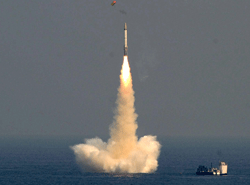
India on Sunday joined a select league of nations with the capability of firing nuclear-tipped missiles from land, air and sea by taking a big step in completing the nuclear triad more than 12 years after Pokhran II nuclear tests.
A successful underwater launch of a ballistic missile took place in the Bay of Bengal off Visakhapatnam on Sunday. The missile was launched from a pontoon and was tested for its full range. It met every mission objective.
All the parameters of the vehicle were monitored by radar all through the trajectory and terminal events took place exactly as expected, the Defence Research and Development Organisation (DRDO), which developed the missile known as B05, said in a statement.
“This was the 11th launch of the missile from underwater. In addition, there were three tests from the land. All tests were highly successful, but they were kept a closely guarded secret. It is a medium range missile, which is now fully developed,” a DRDO spokesperson told Deccan Herald.
Only the USA, France, Russia and China have submarine-launched ballistic missile (SLBM), which India was developing for the better part of the last decade as a reliable second strike capability in case of a nuclear attack.
Following Pokhran II India voluntarily adopted a no-first-use nuclear policy while developing a nuclear triad as part of its credible minimum deterrence.
The triad’s first two legs are Agni missiles with ranges up to 5,000 km and Mirage-2000, Su-30MKI and MiG-29 fighters for delivering nuclear weapons from the land and the sea.
While DRDO did not disclose the SLBM’s range, there were unconfirmed reports in the past that defence scientists were developing two SLBMs — one with a range of about 700 km (K-15) and a second one whose range is upwards 3,000 km (K-4). The B05 missile launched on Sunday was the K-15.
The SLBM may be fitted to indigenous nuclear-powered submarine INS Arihant, which is yet to commence sea trial.
Last December, when Navy Chief Admiral D K Joshi was asked when Arihant would begin sea trial, he said, “The good news is expected shortly” giving rise to speculations on the state of readiness for the 6000-tonne submarine powered by a 80 Mwe indigenous nuclear reactor.
Defence Minister A K Antony informed Parliament last May that Arihant might join the service by the first half of 2013.
Sunday’s trial of the SLBM, claimed DRDO chief V K Saraswat in an interview to PTI, was the last developmental trial and the missile was ready to be integrated with Arihant and other platforms. India is understood to have been developing two more indigenous nuclear-powered attack submarine.
A 28-second video clip released by the DRDO showed the missile emerging from the sea piercing the water.
It flew perfectly in its trajectory and hit the target after six minutes, which was monitored and recorded by naval ships placed along the trajectory.